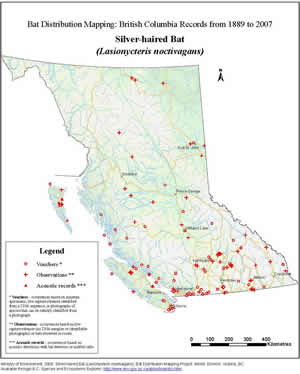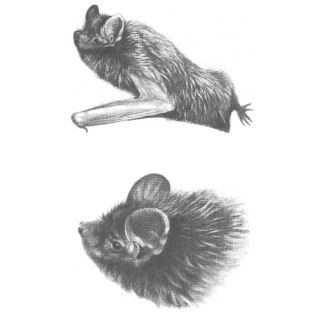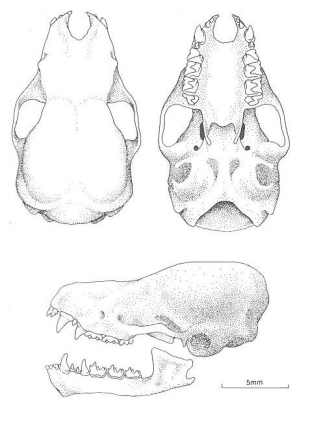Mating is thought to take place during the autumn migration period. Most males and females reach sexual maturity in their first summer. After a gestation period of 50 to 60 days, females give birth to one or two young, with twins more common. The only breeding datum for the province consists of a female collected in the Peace River region on 18 June with two foetuses seven millimetres in size. Birth probably occurs in late June or early July. Newborn young are hairless and weigh about two grams. They develop quickly and by three weeks they can fly.
|
This species emerges about 30 minutes after sunset to hunt in clearings around tree-top level and over water. There are two well-defined peaks in activity: the first between 10 pm and midnight, and the second an hour before dawn. Night-time activity is sharply curtailed when temperatures are below 8°C. Its slow, agile flight and high-frequency echolocation calls enable the Silver-haired Bat to readily detect and intercept small insects at close range. It seems to be particularly adept at exploiting swarms of flying insects. Although some have labelled the Silver-haired Bat a moth specialist, its diet is extremely flexible - it appears to be able exploit whatever insect prey is available. Prey items identified in the diet cover a wide range of small insect species including moths, midges, leafhoppers, caddisflies, flies, beetles, ants and termites.
|
This species is generally regarded as a tree bat, although specific information on its summer roosting habits is rather sketchy. Individuals have been found under the bark of trees and in crevices in tree trunks, abandoned woodpecker holes and bird nests. In the Okanagan Valley cottonwood trees appear to be important roosting sites.
Typically the Silver-haired Bat roosts alone or in small groups of two to six. Even when roosting in groups, individuals are rarely found in close contact. Only two maternity colonies have been found in Canada. Both were small - one with three and the other with eight females - and were situated in cavities excavated by woodpeckers.
No information is available on this bat's use of night roosts.
Most Canadian populations of the Silver-haired Bat are thought to be migratory, overwintering in the United States. Changes in seasonal occurrence suggest that its range shifts northward in spring and southward in winter. But in British Columbia this bat can be found in all seasons. Given this evidence and considerable overlap in the summer and winter ranges, some researchers have concluded that British Columbian populations of the Silver-haired Bat do not migrate. But the majority of records from the province come from spring (May and June) and late summer (August and September), periods when this bat is presumed to migrate. With no information available on movements of individuals, we cannot determine whether these seasonal peaks in occurrence result from an increase in bat activity or an influx of migrating individuals.
During the migration period the Silver-haired Bat uses several different kinds of temporary day roosts. In Manitoba it has been found roosting in the furrowed bark and crevices of large ash and willow trees. Presumably, these crevice roosts provide protection from inclement weather and predators. In urban areas, migrating Silver-haired Bats often roost on the sides of buildings. Each autumn the Royal British Columbia Museum receives several reports of this species roosting on buildings in downtown Victoria. During the day individuals can lower their body temperature and go into torpor in order to conserve energy. Individuals found in this dormant condition are often assumed to be ill. Sometimes during migration periods, this bat is caught in mist nets set by bird banders.
There are winter records from Victoria and Vancouver and from the Okanagan Valley north to Williams Lake. Trees appear to be the most important hibernation sites in the province: Silver-haired Bats have been found hibernating under the bark of Western Red-cedars in Vancouver; one was discovered in a Douglas-fir snag near Kamloops. There is one winter record of an individual hibernating in the attic of a house in Vancouver. Also an active individual was found in an old mine in the south Okanagan in January. Other than it being a cold-hardy bat, little seems to be known about the Silver-haired Bat's specific requirements for hibernation. In old mines, it has been found hibernating in ambient temperatures of -0.5 to -2°C. The northern limits of the winter range suggest that this mammal can overwinter in regions where the average daily temperature for January is above -7°C.
|
|


